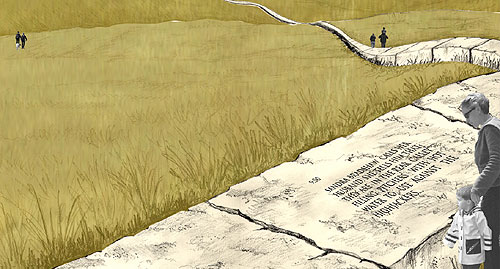Berkeleyan
 The Flight 93 Memorial design created by Leor and Gilat Lovinger calls for a 2.5-mile-long "Bravery Wall" running through the bare, rolling landscape near Somerset, Penn. Visitors would travel by car or walk the length of the wall connecting the interpretive center at the memorial's entrance and the "Sacred Ground" where the plane came down. |
'Disturbed Harmony'![]()
| 31 March 2005
An appreciation for the landscape of southwestern Pennsylvania helped Leor Lovinger (MLA '03) and his wife, Gilat, "put our arms around" the site where Flight 93 went down on Sept. 11, 2001.
The young couple - who met as undergraduates in Israel and moved to Berkeley in summer 2001 - learned earlier this year that jurors had named "Disturbed Harmony" among five finalists in the Flight 93 Memorial Design Competition.
 Leor Lovinger (MLA '03) and his wife Gilat Lovinger |
Leor credits his studies at CED for the "respect for the Pennsylvania vernacular" that informs their plan - citing in particular The Cultural Landscape, a "historic" course originally created by the late J.B. Jackson, and now taught by Professor Paul Groth.
"The course provides you the tools to look at and interpret a landscape and try to understand its geology, culture, and other elements," he says. "Understanding the history and cultural values of a place is one of the first steps one takes before designing."
The Lovingers have entered design competitions together in the past, and have each worked for design firms involved in major memorials - Leor, as an undergraduate, with Dan Zur & Associates (the firm that planned the Holocaust memorial Yad Vashem, in Jerusalem) and Gilat currently for Peter Walker (the landscape architect for the World Trade Center memorial "Reflecting Absence" and former chair of Berkeley's landscape architecture and environmental planning department).
The team will receive a $25,000 honorarium to develop their plan for the final judging (winners to be announced in September) and are currently collaborating with the San Francisco office of Lawrence Halprin, who planned the FDR Memorial in Washington, D.C. A workshop for the finalists was held on Feb. 25 in Somerset, Penn. Leor attended, but Gilat was home in Berkeley with the couple's first child, born three days earlier.
"It's an irony that the biggest things in our personal and professional lives happened at the same time," says Leor. "It was a very emotional month." He notes that the memorial involves "a lot of sensitivities" - not only those of the nation but those of the Somerset community and the relatives and friends of Flight 93 passengers. "The events of Sept. 11 really touched us all.. I cannot express enough how important it is to be able to contribute to this project."
"Disturbed Harmony" can be viewed at www.flight93memorialproject.org/.

